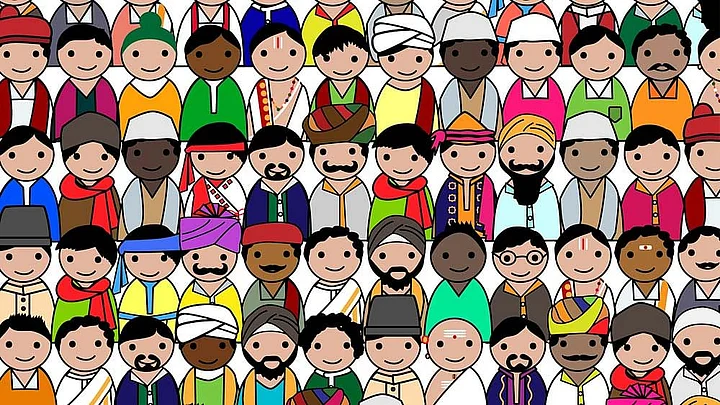A major decline in fertility rates across all religious groups in India has limited changes in the country’s religious composition, found an analytical report released by American think tank Pew Research Centre on Tuesday, 21 September.
The report titled 'Religious Composition of India' describes the religious makeup of India’s population, how it changed between 1951 and 2011, and the main causes of the change.
The findings, based on the country's census data, stated that while the growth rates have declined amongst Hindus, Muslims, Christians, Jains and Buddhists — the slowdown has been more pronounced among religious minorities, who had outpaced Hindus in earlier decades.
Looking at population trends since India’s independence, the report said that before the steep decline in fertility rates, India was on a trajectory that would have resulted in a much larger total population, as well as a greater change in the distribution of religious populations.
But the stabilisation in birth rates over time means that the religious composition has also been largely stable since Partition.
Gap Between Birth Rates in India's Religious Groups Narrowing
If between 1951 and 1961, the Muslim population expanded by 11 percentage points more than India’s overall rate of 21.6 percent, the gap has narrowed drastically over the past decades.
Between 2001 and 2011, the difference in growth among Muslims (24.7 percent) and India's overall rate (17.7 percent) was down 7 percentage points.
"The greatest shift has been a modest rise in the share of Muslims, accompanied by a corresponding decline in the share of Hindus. Between 1951 and 2011, Muslims grew by 4.4 percentage points to 14.2 percent of the population, while Hindus declined by 4.3 percentage points to 79.8 percent," the report said.
While Muslims still have the highest fertility rate among India’s major religious communities, followed by Hindus at 2.1, the gaps in the birth rates between India’s religious groups are getting smaller over the past decades than what they used to be.
The country's Christian population grew at the slowest pace of the three largest groups in the most recent census decade – gaining 15.7 percent between 2001 and 2011, a far lower growth rate than the one recorded in the decade following Partition (29.0 percent).
Moderate Rises and Declines in Hindu and Muslim Population Shares
Overall, between 2001 and 2011, there was relatively little change in the religious composition of states, even as populations soared in almost every state.
India’s most populous states still have large Hindu majorities, the report said, while Muslims and Christians form majorities in some smaller states.
Within states, in most cases, the population shares of religious groups did not change by more than a small fraction of 1 percent.
This was particularly true for Hindus, who generally held steady or declined only modestly as a share of state populations. Muslims, too, maintained their population shares within states or increased only slightly between 2001 and 2011.
For instance, in West Bengal, Muslims grew by 1.8 percentage points, and in Jammu and Kashmir, they grew by 1.3 points. The only state in which the Muslim share dropped was Manipur, with a 0.4 percentage points decrease.
Geographic Distribution of Religious Groups Largely Unchanged Despite Migration
Although migration contributes to shifting demographies, in the case of India, despite migration of millions of people to or outside of India, the geographic distribution of religious groups has largely remained stable since Partition, the report noted.
This is because the migration numbers are smaller relative to the overall population.
Currently, the concentration of Christians is still higher in the southern states of Kerala and Tamil Nadu and around the smaller Northeastern states. Jammu and Kashmir is the only place with a Muslim majority, except for the sparsely populated archipelago of Lakshadweep.
Buddhists and Jains are most often found in Maharashtra, and Sikhs in Punjab, where they make up a majority, while nearly every other state and territory has a large Hindu majority.
Conversion, Immigration Hasn't Drastically Impacted Religious Demographies
Allegations of 'love jihad' and unlawful conversions of Hindu women under the guile of marriage have been propagated by elected representatives in India on several occasions.
Even as the propaganda has been proven to be untrue many times, the Pew report backs the fact that the number of Indians who switch religions is modest and does not appear to be a major factor in demographic change.
In a 2020 Pew Research Center survey of nearly 30,000 adults across India, very few indicated they had switched religions since childhood.
Among adults who say they were raised as Hindus, 99 percent still identify as Hindus. Similarly, 97 percent of those raised as Muslims are still Muslims in adulthood. And among Indians who were raised as Christians, 94 percent are still Christians.
Moreover, those who do switch religions tend to cancel each other out; among all Indian adults, the report said, 0.7 percent were raised Hindu but do not currently identify as such, while 0.8 percent were raised outside of the religion but are now Hindu.
In addition, the available data indicates that Muslims are more likely than Hindus to leave India, and immigrants into India from Muslim-majority countries are disproportionately Hindu.
In 2019, Parliament passed the Citizenship Amendment Bill granting expedited citizenship to many Hindu, Christian, Jain, Sikh, Parsi and Buddhist – but not Muslim – immigrants who have fled persecution in neighbouring countries.
(Corrigendum: An earlier version of the story incorrectly depicted Muslim women having an average of 5 children in 1992. The fertility rate was at 3.3 for Muslims around that period. The error is regretted.)
(At The Quint, we question everything. Play an active role in shaping our journalism by becoming a member today.)
